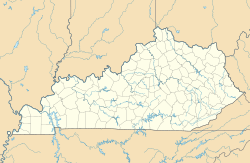Turk Site facts for kids

Looking toward the site from the south
|
|
| Location | Bardwell, Kentucky, Carlisle County, Kentucky, |
|---|---|
| Region | Jackson Purchase |
| Coordinates | 36°53′41.17″N 89°5′6.79″W / 36.8947694°N 89.0852194°W |
| History | |
| Cultures | Mississippian culture |
| Site notes | |
| Architecture | |
| Architectural styles | Platform mounds, Plaza |
| Responsible body: private | |
The Turk Site (also known by its site number, 15CE6) is an ancient village site built by the Mississippian culture. It's located near Bardwell, Kentucky in Carlisle County, Kentucky. This special place sits on a high piece of land overlooking the Mississippi River floodplain, which is the flat land next to the river.
Contents
Exploring the Turk Site
The Turk Site covers about 2.5 hectares (that's about 6 acres, or roughly the size of five football fields!). People lived here mainly during two time periods. The first was the Dorena Phase, from about 1100 to 1300 CE. The second was the Medley Phase, from 1300 to 1500 CE.
Who Lived at Turk Site?
It's possible that the people who lived at the Turk Site moved there from another nearby settlement. This older village was called the Marshall Site. It was located on the next high piece of land, or bluff spur, over from Turk.
How Was the Site Designed?
Even though the Turk Site was an important place for the region, it was not very big. This was because of the shape of the land it was built on. The site was laid out in a typical Mississippian way. It had several platform mounds. These were flat-topped hills that people built. Important buildings, like temples or chiefs' homes, would have stood on top of them. These mounds were arranged around a central open area called a plaza. The plaza was likely used for gatherings, ceremonies, and games.
Archaeological Discoveries
The first time someone wrote about investigating the Turk Site was in 1888. This was done by a person named Robert Loughridge. The most detailed work at the site happened much later. Richard Edging led this work, and his findings were published in 1985. These studies help us understand how people lived at the Turk Site long ago.


